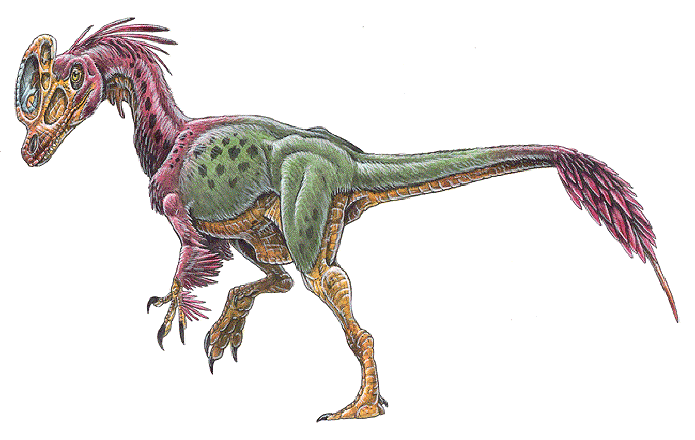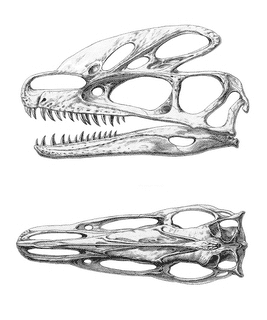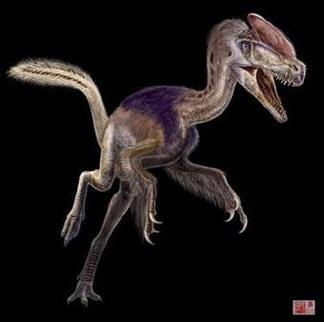|
|
|
Guanlong wucaii (Xomg Xu, 2006) |
 |
|
Name Means: |
"Crowned Dragon" |
Length: |
25 - 30 feet (7 - 9 m) |
|
Pronounced: |
|
Weight: |
1-2 tons(900 - 1,800 kilos) |
|
When it lived: |
160 MYA |
|
|
|
Where found: |
China |
|
|
|
A Chinese paleontology discovery team recently discovered the oldest
ancestor to the Tyrannosaurus Rex. The species, named Guanlong wucaii,
or "crown dragon from the land of five colors" is believed to be 160
million years old. Gualong was discovered a northwestern Chinese
desert. A great crest of delicate structure crossed its snout
longitudinally.
Scientists say that the creature lived before the T-Rex by 90
million years. Although the Guanlong was considered a predator, it was
not the most notable one of its time. However, scientists believe that
it could easily outrun its enemies. The notable feature of the
skeleton was a large crest on its snout, which is uncharacteristic of
meat-eating dinosaurs. The leader of the team, Xing Xu, was from
China's Institute of Vertebrate Paleontology. A professor from George
Washington Unviersity, James M. Clark, helped lead the expedition with
Xu, after reported findings of fossils in the area during a search for
oil. |
|
Like the Dilong , the
"crowned dragoon" also comes from China, but he is still more old: it
lived approximately 160 million ago years (jurásico delayed). |
|
|
 |
|
Reduced consensus analysis demonstrates that Guanlong is
outside of the Tyrannosauridae–Dilong clade on all trees, but
the position of Stokesosaurus is unstable (see Supplementary
Information). 1, Coelurosauria; 2, Tyrannosauroidea. Bootstrap value
(90%) is high for the Tyrannosauroidea including Guanlong wucaii. |
|
Discovery |
|
Albertosaurus bones
were among the earliest dinosaur remains collected in Alberta, Canada.
A partial skull was found
by J.B. Tyrrell in 1884 was the first important dinosaur fossil to be
discovered along the Red Deer River. It was named Albertosaurus
sarcophagusin in 1905, the same year that Alberta became a province.
It is the type species of
the genera. For many years
there was only skull material and only one reasonably complete
skeleton. This is unusual as there have been at least one or two
complete skulls found for all other North American tyrannosaurs. |
|
Royal Tyrell Museum |
Joseph Burr Tyrrell was not a
paleontologist. He was a geologist who explored much of western
Canada during the late 1800s and early 1900s. He claimed no
priority in the discovery of dinosaurs in the Red Deer River Valley.
And yet, it is his name that is attached to the premier
paleontological museum in North America -- the one with a major focus
on Red Deer Valley dinosaurs -- the Royal Tyrrell Museum of
Palaeontology in Drumheller.
The exact location of the bonebed discovered by Tyrell has been
lost for many years. But Dr. Philip Currie, paleontologist of
the Royal Tyrell Museum recently found nine Albertosaurus sarcophagus fossils together. Since
these dinosaurs were of different ages, they were probably from a
herd/pack that lived together (at least temporarily). The idea of a
pack of these enormous predators hunting together is extremely scary. The
smallest documented Albertosaurus, a juvenile less than a quarter of
the size of a full grown adult, was collected from Sandy Point on the
South Saskatchewan River in 1986. |
|
Species |
There are two species of Albertosaurus
Albertosaurus sarcophagus
Described above. Stripped of the remains assigned to Gorgosaurus, this
taxon was known mainly from two partial skulls and skeletons.
Recently found
bone bed material will add 9 individuals
in three general size classes.
Albertosaurus arctunguis (Parks, 1928).
Skull length : up to 1 m.; Total length : 8 m.; Hip height : 2.5 m.;
Weight : 2 ton
Albertosaurus libratus (Lambe, 1914) is today known as the
Gorgosaurus libratus. (listed at left). This change of genera is advocated by
many paleontologists, who claim that there are enough differences
between A. libratus and the other Albertosaurus species
to resurrect the older genus name of
Gorgosaurus. Skull length : up to 1 m.; Total length : 8.6 m.;
Hip height : 2.8 m; Weight : 2.5 tonnes |
|
|
|
|
|
|
|
|
Edugraphics.Net | Feenixx Publishing |
|
|
|
|



